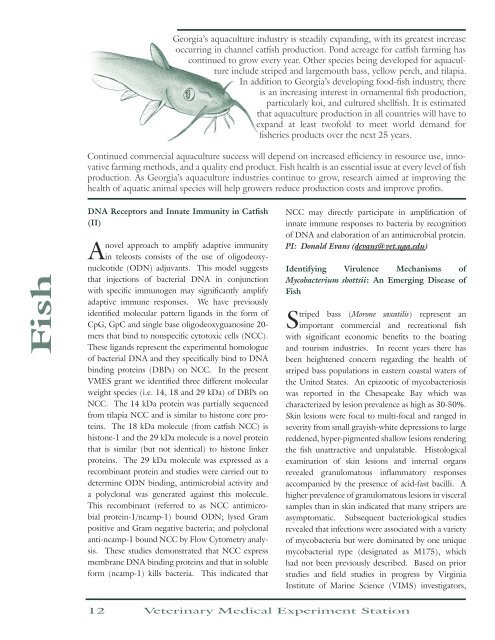Agroterrorism - University of Georgia College of Veterinary Medicine
Agroterrorism - University of Georgia College of Veterinary Medicine
Agroterrorism - University of Georgia College of Veterinary Medicine
- No tags were found...
You also want an ePaper? Increase the reach of your titles
YUMPU automatically turns print PDFs into web optimized ePapers that Google loves.
<strong>Georgia</strong>’s aquaculture industry is steadily expanding, with its greatest increaseoccurring in channel catfish production. Pond acreage for catfish farming hascontinued to grow every year. Other species being developed for aquacultureinclude striped and largemouth bass, yellow perch, and tilapia.In addition to <strong>Georgia</strong>’s developing food-fish industry, thereis an increasing interest in ornamental fish production,particularly koi, and cultured shellfish. It is estimatedthat aquaculture production in all countries will have toexpand at least tw<strong>of</strong>old to meet world demand forfisheries products over the next 25 years.Continued commercial aquaculture success will depend on increased efficiency in resource use, innovativefarming methods, and a quality end product. Fish health is an essential issue at every level <strong>of</strong> fishproduction. As <strong>Georgia</strong>’s aquaculture industries continue to grow, research aimed at improving thehealth <strong>of</strong> aquatic animal species will help growers reduce production costs and improve pr<strong>of</strong>its.FishDNA Receptors and Innate Immunity in Catfish(II)novel approach to amplify adaptive immunityA in teleosts consists <strong>of</strong> the use <strong>of</strong> oligodeoxynucleotide(ODN) adjuvants. This model suggeststhat injections <strong>of</strong> bacterial DNA in conjunctionwith specific immunogen may significantly amplifyadaptive immune responses. We have previouslyidentified molecular pattern ligands in the form <strong>of</strong>CpG, GpC and single base oligodeoxyguanosine 20-mers that bind to nonspecific cytotoxic cells (NCC).These ligands represent the experimental homologue<strong>of</strong> bacterial DNA and they specifically bind to DNAbinding proteins (DBPs) on NCC. In the presentVMES grant we identified three different molecularweight species (i.e. 14, 18 and 29 kDa) <strong>of</strong> DBPs onNCC. The 14 kDa protein was partially sequencedfrom tilapia NCC and is similar to histone core proteins.The 18 kDa molecule (from catfish NCC) ishistone-1 and the 29 kDa molecule is a novel proteinthat is similar (but not identical) to histone linkerproteins. The 29 kDa molecule was expressed as arecombinant protein and studies were carried out todetermine ODN binding, antimicrobial activity anda polyclonal was generated against this molecule.This recombinant (referred to as NCC antimicrobialprotein-1/ncamp-1) bound ODN; lysed Grampositive and Gram negative bacteria; and polyclonalanti-ncamp-1 bound NCC by Flow Cytometry analysis.These studies demonstrated that NCC expressmembrane DNA binding proteins and that in solubleform (ncamp-1) kills bacteria. This indicated thatNCC may directly participate in amplification <strong>of</strong>innate immune responses to bacteria by recognition<strong>of</strong> DNA and elaboration <strong>of</strong> an antimicrobial protein.PI: Donald Evans (devans@vet.uga.edu)Identifying Virulence Mechanisms <strong>of</strong>Mycobacterium shottsii: An Emerging Disease <strong>of</strong>FishStriped bass (Morone saxatilis) represent animportant commercial and recreational fishwith significant economic benefits to the boatingand tourism industries. In recent years there hasbeen heightened concern regarding the health <strong>of</strong>striped bass populations in eastern coastal waters <strong>of</strong>the United States. An epizootic <strong>of</strong> mycobacteriosiswas reported in the Chesapeake Bay which wascharacterized by lesion prevalence as high as 30-50%.Skin lesions were focal to multi-focal and ranged inseverity from small grayish-white depressions to largereddened, hyper-pigmented shallow lesions renderingthe fish unattractive and unpalatable. Histologicalexamination <strong>of</strong> skin lesions and internal organsrevealed granulomatous inflammatory responsesaccompanied by the presence <strong>of</strong> acid-fast bacilli. Ahigher prevalence <strong>of</strong> granulomatous lesions in visceralsamples than in skin indicated that many stripers areasymptomatic. Subsequent bacteriological studiesrevealed that infections were associated with a variety<strong>of</strong> mycobacteria but were dominated by one uniquemycobacterial type (designated as M175), whichhad not been previously described. Based on priorstudies and field studies in progress by VirginiaInstitute <strong>of</strong> Marine Science (VIMS) investigators,12 <strong>Veterinary</strong> Medical Experiment Station
















